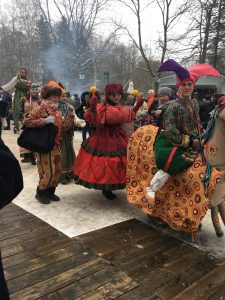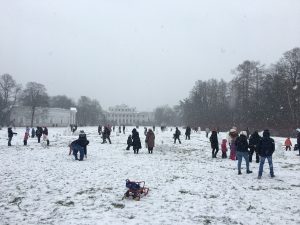 Масленица – это русский праздник. Он возник как языческий праздник Нового года, приветствующий приход весны, собирающий семьи, поминающий умерших и поедающий блины! Несмотря на то, что Масленица была языческим праздником, она была сохранена Православной Церковью и стала празднованием последней недели перед Великим постом. В Санкт-Петербурге в воскресенье 1 марта состоялся Масленичный праздник на Елегином острове-прекрасном парке на севере города. Этот праздник был кульминацией масленичной недели, и было много празднеств; я видела, как пели хоры (“пьяный матрос”!), играющие дети (на сохранившихся садах), маленькие соломенные чучела, сжигаемые детьми и раздаваемые уличными торговцами без чучела того же самого в украшении, много традиционных танцев, но самое главное, много киосков, продающих вкусные блины и пышки с множеством различных начинок!
Масленица – это русский праздник. Он возник как языческий праздник Нового года, приветствующий приход весны, собирающий семьи, поминающий умерших и поедающий блины! Несмотря на то, что Масленица была языческим праздником, она была сохранена Православной Церковью и стала празднованием последней недели перед Великим постом. В Санкт-Петербурге в воскресенье 1 марта состоялся Масленичный праздник на Елегином острове-прекрасном парке на севере города. Этот праздник был кульминацией масленичной недели, и было много празднеств; я видела, как пели хоры (“пьяный матрос”!), играющие дети (на сохранившихся садах), маленькие соломенные чучела, сжигаемые детьми и раздаваемые уличными торговцами без чучела того же самого в украшении, много традиционных танцев, но самое главное, много киосков, продающих вкусные блины и пышки с множеством различных начинок!
 В течение масленичной недели Православным Христианам запрещено есть мясо, и это последняя неделя, в течение которой разрешены яйца, молоко, сыр и другие молочные продукты, что приводит к ее названию “Сырная неделя”.”
В течение масленичной недели Православным Христианам запрещено есть мясо, и это последняя неделя, в течение которой разрешены яйца, молоко, сыр и другие молочные продукты, что приводит к ее названию “Сырная неделя”.”
Вход на праздник стоил всего 50 рублей (около 60 пенсов)и давал нам доступ ко всем праздникам. Однако, хотя это был праздник начала весны, весь день бушевала метель и было минус 5 градусов. Чтобы не испортить веселье, глинтвейн согревал нас.
К другим древним традициям относятся кулачные бои, показанные в знаменитом фильме Никиты Михалкова “Сибирский цирюльник”; бои были опасны, и иногда люди умирали, что рассматривалось как жертвоприношение богам и земле. Я связала эту сцену ниже:
Последняя традиция-сожжение большого чучела, украшенного тряпками. В конце недели его сожгут, а пепел развеют по всему полю . В то время как люди делали это, они пели песни, чтобы поощрить обильный урожай в течение года.
 Maslenitsa is the Russian celebration. It originated as the pagan New Year celebration welcoming the arrival of spring, bringing together families, commemorating the dead, and eating pancakes! Despite being a pagan festival, Maslenitsa was preserved by the Orthodox Church and became a celebration of the last week before Lent. In St. Petersburg on Sunday the 1st March, the Maslenitsa fayre was held on Yelegin island – a beautiful park in the north of the city. This fayre was the culmination of the shrovetide week and there were many festivities; I saw choirs singing (‘A Drunken Sailor’!), children playing (on preserved gardens), small straw effigies being burnt by children and handed out by street vendors with no effigy the same in decoration, lots of traditional dancing, but most importantly, many stalls selling delicious pancakes and crumpets with many different fillings!
Maslenitsa is the Russian celebration. It originated as the pagan New Year celebration welcoming the arrival of spring, bringing together families, commemorating the dead, and eating pancakes! Despite being a pagan festival, Maslenitsa was preserved by the Orthodox Church and became a celebration of the last week before Lent. In St. Petersburg on Sunday the 1st March, the Maslenitsa fayre was held on Yelegin island – a beautiful park in the north of the city. This fayre was the culmination of the shrovetide week and there were many festivities; I saw choirs singing (‘A Drunken Sailor’!), children playing (on preserved gardens), small straw effigies being burnt by children and handed out by street vendors with no effigy the same in decoration, lots of traditional dancing, but most importantly, many stalls selling delicious pancakes and crumpets with many different fillings!
 During the week of Maslenitsa, meat is forbidden to Orthodox Christians, and it is the last week during which eggs, milk, cheese and other dairy products are permitted, leading to its name of “Cheese-fare week”
During the week of Maslenitsa, meat is forbidden to Orthodox Christians, and it is the last week during which eggs, milk, cheese and other dairy products are permitted, leading to its name of “Cheese-fare week”
Entry to the fayre was only 50 rubles (around 60 pence) and granted us access to all the festivities. However, although this was the celebration of the beginning of Spring, it was blizzarding all day and was minus 5 degrees. Not to spoil the fun, the mulled wine kept us warm.
Other ancient traditions include the fist fights that were shown in Nikita Mikhalkov’s famous film ‘The Siberian Barber’; the fights were dangerous and sometimes people died which were seen as a sacrificial offering to the Gods and to the land. I have linked the scene below:
The final tradition is the burning of the large effigy decorated in rags. It would be burned at the end of the week and the ashes would be scattered around the field . Whilst the people did this they would sing songs to encourage an abundant harvest for the year.
